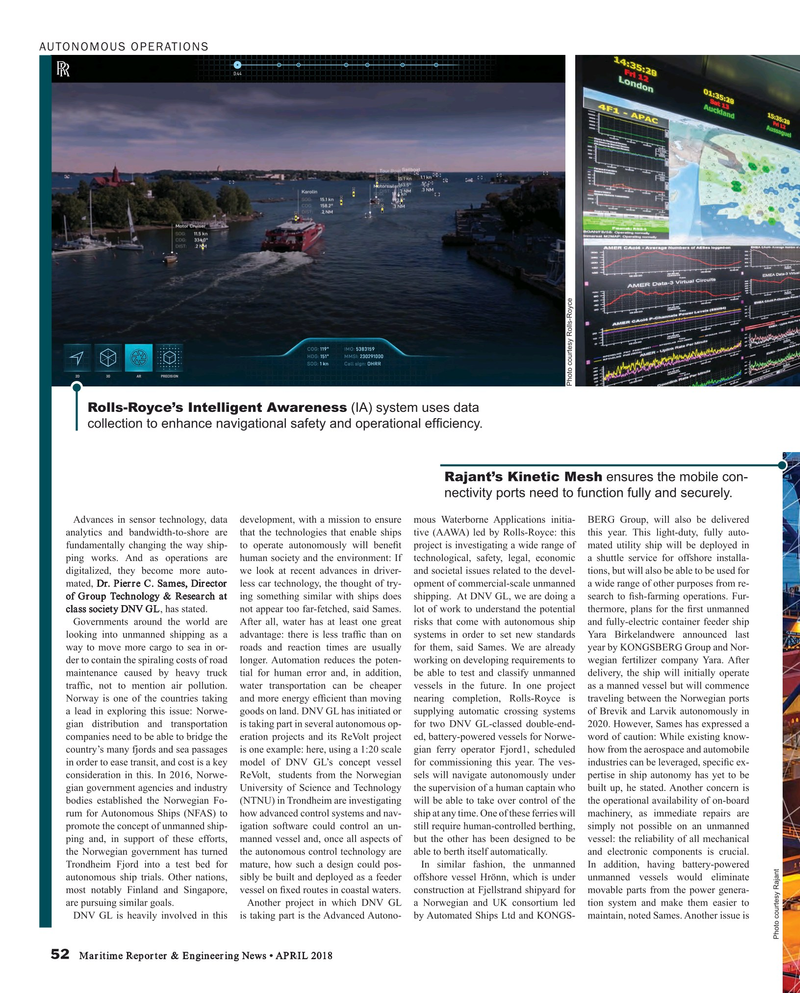
Page 52: of Maritime Reporter Magazine (April 2018)
Offshore Energy Annual
Read this page in Pdf, Flash or Html5 edition of April 2018 Maritime Reporter Magazine
AUTONOMOUS OPERATIONS
Photo courtesy Rolls-Royce
Rolls-Royce’s Intelligent Awareness (IA) system uses data collection to enhance navigational safety and operational ef? ciency.
Rajant’s Kinetic Mesh ensures the mobile con- nectivity ports need to function fully and securely.
Advances in sensor technology, data development, with a mission to ensure mous Waterborne Applications initia- BERG Group, will also be delivered analytics and bandwidth-to-shore are that the technologies that enable ships tive (AAWA) led by Rolls-Royce: this this year. This light-duty, fully auto- fundamentally changing the way ship- to operate autonomously will bene? t project is investigating a wide range of mated utility ship will be deployed in ping works. And as operations are human society and the environment: If technological, safety, legal, economic a shuttle service for offshore installa- digitalized, they become more auto- we look at recent advances in driver- and societal issues related to the devel- tions, but will also be able to be used for mated, Dr. Pierre C. Sames, Director less car technology, the thought of try- opment of commercial-scale unmanned a wide range of other purposes from re- of Group Technology & Research at ing something similar with ships does shipping. At DNV GL, we are doing a search to ? sh-farming operations. Fur- class society DNV GL, has stated. not appear too far-fetched, said Sames. lot of work to understand the potential thermore, plans for the ? rst unmanned
Governments around the world are After all, water has at least one great risks that come with autonomous ship and fully-electric container feeder ship looking into unmanned shipping as a advantage: there is less traf? c than on systems in order to set new standards Yara Birkelandwere announced last way to move more cargo to sea in or- roads and reaction times are usually for them, said Sames. We are already year by KONGSBERG Group and Nor- der to contain the spiraling costs of road longer. Automation reduces the poten- working on developing requirements to wegian fertilizer company Yara. After maintenance caused by heavy truck tial for human error and, in addition, be able to test and classify unmanned delivery, the ship will initially operate traf? c, not to mention air pollution. water transportation can be cheaper vessels in the future. In one project as a manned vessel but will commence
Norway is one of the countries taking and more energy ef? cient than moving nearing completion, Rolls-Royce is traveling between the Norwegian ports a lead in exploring this issue: Norwe- goods on land. DNV GL has initiated or supplying automatic crossing systems of Brevik and Larvik autonomously in gian distribution and transportation is taking part in several autonomous op- for two DNV GL-classed double-end- 2020. However, Sames has expressed a companies need to be able to bridge the eration projects and its ReVolt project ed, battery-powered vessels for Norwe- word of caution: While existing know- country’s many fjords and sea passages is one example: here, using a 1:20 scale gian ferry operator Fjord1, scheduled how from the aerospace and automobile in order to ease transit, and cost is a key model of DNV GL’s concept vessel for commissioning this year. The ves- industries can be leveraged, speci? c ex- consideration in this. In 2016, Norwe- ReVolt, students from the Norwegian sels will navigate autonomously under pertise in ship autonomy has yet to be gian government agencies and industry University of Science and Technology the supervision of a human captain who built up, he stated. Another concern is bodies established the Norwegian Fo- (NTNU) in Trondheim are investigating will be able to take over control of the the operational availability of on-board rum for Autonomous Ships (NFAS) to how advanced control systems and nav- ship at any time. One of these ferries will machinery, as immediate repairs are promote the concept of unmanned ship- igation software could control an un- still require human-controlled berthing, simply not possible on an unmanned ping and, in support of these efforts, manned vessel and, once all aspects of but the other has been designed to be vessel: the reliability of all mechanical the Norwegian government has turned the autonomous control technology are able to berth itself automatically. and electronic components is crucial.
Trondheim Fjord into a test bed for mature, how such a design could pos- In similar fashion, the unmanned In addition, having battery-powered autonomous ship trials. Other nations, sibly be built and deployed as a feeder offshore vessel Hrönn, which is under unmanned vessels would eliminate most notably Finland and Singapore, vessel on ? xed routes in coastal waters. construction at Fjellstrand shipyard for movable parts from the power genera- are pursuing similar goals. Another project in which DNV GL a Norwegian and UK consortium led tion system and make them easier to
DNV GL is heavily involved in this is taking part is the Advanced Autono- by Automated Ships Ltd and KONGS- maintain, noted Sames. Another issue is
Photo courtesy Rajant 52 Maritime Reporter & Engineering News • APRIL 2018
MR #4 (50-58).indd 52 MR #4 (50-58).indd 52 4/6/2018 9:38:38 AM4/6/2018 9:38:38 AM

 51
51

 53
53
